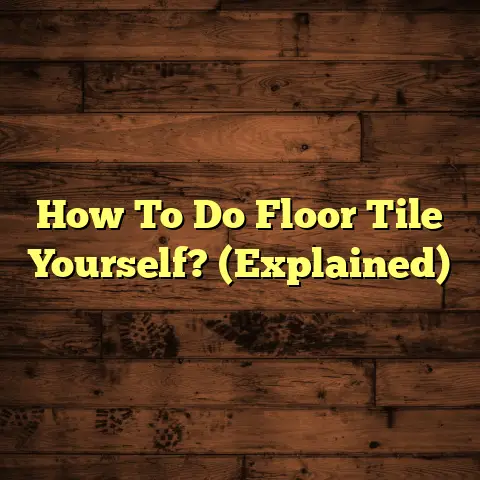Different Color Wood Floors? (4 Design Fails!)
From the sublime to the… well, let’s just say, less sublime.
Today, we’re diving deep into the world of colored wood floors.
They’re trendy, they’re expressive, and they can completely transform a space.
But, like any powerful design element, they can also go horribly wrong if you’re not careful.
And believe me, I’ve seen the aftermath of some serious flooring faux pas.
We’ll discuss the importance of sustainability in modern interior design and how the choice of flooring, particularly wood floors, can significantly impact the environment.
Mention the increasing popularity of sustainable wood sourcing and eco-friendly finishes.
I will introduce the idea that while colored wood floors can add a unique aesthetic, they can also lead to design pitfalls if not executed properly.
So, grab a coffee (or maybe a glass of wine – no judgment here!), and let’s explore the potential pitfalls of colored wood floors and how to avoid them.
The Allure of Colored Wood Floors
Okay, let’s be honest, the allure is strong, right?
Colored wood floors are having a moment.
Gray, whitewashed, ebony, even bold blues and greens – the options are endless.
I’ve personally installed floors in every shade imaginable, and it’s exciting to see homeowners embracing color in such a fundamental way.
Why the trend?
Well, a lot of it has to do with the psychological impact of color.
Think about it:
-
Gray: Sophisticated, calming, and modern. It’s like a blank canvas for your furniture.
-
Whitewashed: Bright, airy, and beachy. Instantly makes a space feel bigger and more relaxed.
-
Dark/Ebony: Dramatic, luxurious, and grounding. Adds a sense of depth and richness.
-
Bold Colors (Blue, Green, etc.): Playful, unique, and expressive. A real statement piece.
Color impacts our mood, our energy levels, and even our perception of space.
That’s powerful stuff!
And the great thing is, you’ve got options!
You can achieve these looks with:
- Reclaimed Wood: Adds character and history, often with unique color variations.
- Engineered Wood: Offers stability and a wide range of color options, often pre-finished.
- Traditional Hardwoods: Can be stained or painted to achieve any color you desire.
I always advise my clients to consider the source of their wood.
Sustainability is becoming increasingly important, and there are fantastic options available.
Look for certifications like the Forest Stewardship Council (FSC) to ensure the wood comes from responsibly managed forests.
Also, consider low-VOC (volatile organic compounds) finishes to minimize off-gassing and improve indoor air quality.
According to the EPA, some wood floor finishes can release harmful VOCs, so it’s crucial to choose wisely.
Now, with all that said, let’s get to the real reason you’re here: the design fails.
Because, trust me, I’ve seen them.
And I’m here to help you avoid them.
Design Fail #1: Choosing the Wrong Color for the Space
This is probably the most common mistake I see.
People get caught up in a color they love without considering how it will actually work in their space.
It’s like buying a killer pair of shoes that look amazing but are torture to wear.
Let’s break it down:
-
Small Spaces: Dark colors (like dark grays or ebony) can make a small space feel even smaller and cramped.
They absorb light and visually shrink the room.
Think about it: would you paint a tiny closet black? Probably not.
Lighter colors, on the other hand, reflect light and make the space feel more open and airy.
Whitewashed, light gray, or even a natural wood finish are great choices for small rooms.
-
Large Spaces: While you have more freedom in larger spaces, you still need to consider the overall effect.
A very light color might feel cold and sterile in a large room.
Medium tones or even darker colors can help ground the space and make it feel more inviting.
-
Natural Light: This is crucial.
A color that looks amazing in a showroom under bright lights might look completely different in your home, especially if you have limited natural light.
If your room is naturally dark, avoid dark floor colors.
They’ll just make the space feel like a cave.
Opt for lighter colors that will bounce light around the room.
-
Room Purpose: What’s the function of the room?
A bedroom, for example, might benefit from calming, neutral colors like soft grays or warm beiges.
A playroom, on the other hand, might be a place to experiment with brighter, more playful colors.
A kitchen sees a lot of traffic and mess, so a mid-tone color that hides dirt and scratches might be a practical choice.
-
Overall Color Palette: Your floor color needs to work with the rest of your décor.
Consider your wall color, furniture, and accessories.
Do you want the floor to be a focal point, or do you want it to blend in?
If you have bold furniture, a neutral floor might be the best choice.
If you have neutral furniture, you can afford to be a bit more adventurous with your floor color.
I always recommend getting samples of different colors and placing them in the room to see how they look at different times of day.
Live with the samples for a few days before making a decision.
It’s a small investment that can save you a lot of heartache (and money!) in the long run.
I had a client once who was obsessed with a dark charcoal gray floor.
Her living room, however, was small and had only one small window.
I tried to gently steer her towards a lighter color, but she was adamant.
The result?
The room felt like a dungeon.
She ended up having to repaint the walls a very light color and add a ton of extra lighting to compensate for the dark floor.
It was a costly mistake that could have been avoided with a little more forethought.
Design Fail #2: Inconsistent Color Choices
This is where things can get really tricky, especially in open floor plans.
Mismatched wood flooring in adjoining spaces can create a jarring and disjointed feel.
It’s like wearing two different shoes – it just doesn’t look right.
Here’s what I mean:
-
Open Floor Plans: In open-concept homes, the flooring often flows seamlessly from one room to another.
If you have different colors in different areas, it can break up the space and make it feel smaller.
Ideally, you want to create a sense of continuity.
If you do want to use different colors, make sure they complement each other.
For example, you could use a lighter shade of the same color in one area and a darker shade in another.
Or, you could use two completely different colors that are still harmonious.
Think about analogous colors (colors that are next to each other on the color wheel) or complementary colors (colors that are opposite each other on the color wheel).
-
Adjoining Spaces: Even if you don’t have an open floor plan, the transition between rooms is important.
If you have a dark wood floor in your hallway and a light wood floor in your living room, the contrast can be too stark.
Consider using a transition strip that incorporates both colors to create a smoother transition.
-
Visual Chaos: Too much variation in color can create a sense of visual chaos.
It can be overwhelming and distracting, making it difficult to relax and enjoy the space.
Aim for a sense of balance and harmony.
I once worked on a house where the homeowner had decided to use a different wood floor color in every single room.
There was a light oak in the living room, a dark walnut in the dining room, a gray maple in the kitchen, and a red cherry in the bedrooms.
It was a disaster.
The house felt choppy and disjointed, and there was no sense of flow.
It was a classic case of “too much of a good thing.”
I ended up recommending that she refinish all the floors in a consistent color to create a more cohesive look.
It was a significant investment, but it made a world of difference.
Design Fail #3: Ignoring the Transition Between Rooms
Okay, so you’ve chosen your colors, and you’re feeling good.
But don’t forget about the transitions!
This is where a lot of people drop the ball.
An abrupt change in wood color can be jarring and create a disjointed feel, even if the colors themselves are beautiful.
Here’s what to consider:
-
Thresholds: The transition between two different flooring types (e.g., wood and tile) or two different wood colors is crucial.
Use a transition strip that complements both colors.
There are tons of options available, from simple wood strips to more decorative metal or stone thresholds.
-
Gradual Transitions: If you’re using different colors in adjoining spaces, consider a gradual transition.
For example, you could use a rug that incorporates both colors to bridge the gap.
Or, you could use a border of one color around the perimeter of the room to tie it into the adjacent space.
-
Patterned Transitions: Get creative!
You could use a patterned transition, like a herringbone or chevron pattern, to blend the two colors together.
This is a great way to add visual interest and create a seamless transition.
-
Doorways: Pay attention to the flooring under doorways.
If you have a dark wood floor in one room and a light wood floor in the adjacent room, consider extending the darker color slightly under the doorway to create a visual anchor.
I had a client who had installed a beautiful new hardwood floor in her kitchen.
She chose a light, airy color that looked amazing with her white cabinets.
However, the kitchen opened directly into the living room, which had a dark, traditional wood floor.
The transition was so abrupt that it felt like you were stepping into a completely different house.
I suggested adding a custom-made rug that incorporated both colors to soften the transition.
It made a huge difference!
The rug tied the two spaces together and created a more harmonious feel.
Even if different colored wood floors are used, you need to approach transitions thoughtfully.
Design Fail #4: Overly Trendy Choices
Ah, trends.
They’re tempting, I know.
But chasing trends without considering your personal style or the long-term implications can be a recipe for disaster.
Here’s why:
-
Dated Quickly: What’s hot today might be not tomorrow.
Trendy colors can quickly feel dated and lead to costly renovations down the road.
Remember the avocado green and harvest gold of the 70s?
Or the mauve and teal of the 80s?
Those colors were all the rage at the time, but they quickly fell out of favor.
The same can happen with flooring.
-
Personal Style: Your home should reflect your personal style, not just the latest trends.
Choose colors that you love and that you’ll be happy living with for years to come.
Don’t let trends dictate your choices.
-
Timelessness: Opt for classic, timeless colors that will never go out of style.
Natural wood tones, warm beiges, and soft grays are always a safe bet.
They’re versatile and can be easily adapted to different styles.
-
Resale Value: If you’re planning to sell your home in the future, consider the impact of your flooring choices on resale value.
Trendy colors might appeal to some buyers, but they might turn off others.
Neutral colors are generally a safer bet.
I remember a few years ago when gray wood floors were everywhere.
Everyone wanted them.
I installed them in countless homes.
But now, I’m starting to see a backlash.
People are realizing that gray can be cold and sterile, and they’re looking for warmer, more inviting colors.
Some of those homeowners who jumped on the gray bandwagon are now regretting their decision.
They’re stuck with a floor that feels dated and doesn’t reflect their current style.
The lesson?
Choose colors that you love and that you’ll be happy living with for the long haul, not just what’s popular at the moment.
Conclusion
So, there you have it: the four biggest design fails when it comes to colored wood floors.
Choosing colored wood floors can enhance a home’s aesthetic, they require careful consideration to avoid these common design fails.
I hope this article has given you some food for thought and helped you avoid some common pitfalls.
Remember, the key to success is thoughtful selection.
Take your time, consider your space, and choose colors that you love and that reflect your personal style.
And don’t be afraid to ask for help!
A good flooring contractor or interior designer can provide valuable guidance and help you make the right choices for your home.
Happy flooring!





